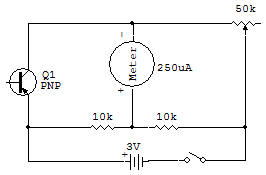
Electronic Thermometer

This experiment demonstrates the thermal sensitivity of semi-conductors and is the basic circuit used in most electronic thermometers. The temperature sensitive element is a common silicon Transistor (2SC).
Bias voltage is constantly applied to the base of the 2SC Transistor by the 47K Resistor and the 50K potentiometer (Control). Current is flowing into the base at the same time.
As the temperature of the Transistor is raised, the base current increases even though the bias voltage is kept constant. The increasing base current causes the collector current to increase which increases the Meter reading.
After wiring the circuit, use the Control to adjust the Meter pointer to the center of the scale. Gently hold the 2SC Transistor between your thumb and forefinger, the Meter pointer will move as the Transistor temperature changes.
Try measuring such temperature differences as body-temperature to room-temperature, room-temperature to outside-temperature, and shade-temperature to sunshine-temperature. Battery current drain is very low for this circuit so hours of use will make little change in Battery life.
